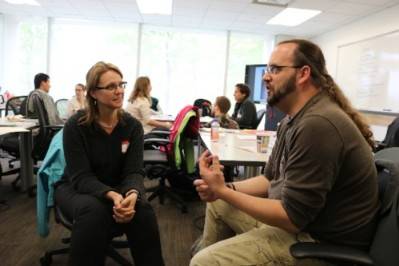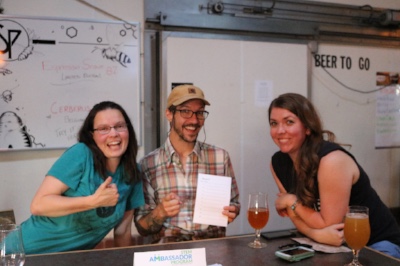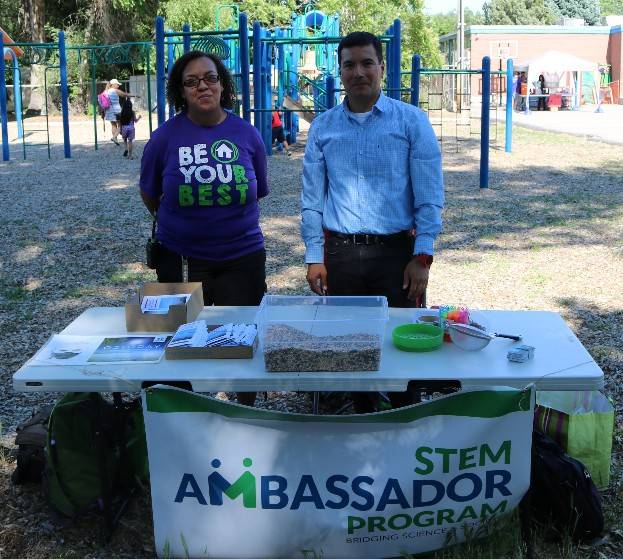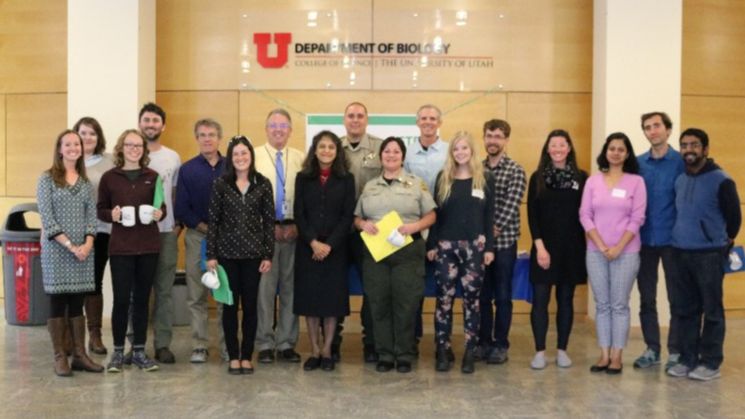Summer 2018 Newsletter
Letter From STEMAP TEAM
Dear STEM Ambassadors and Community Partners,
Welcome to the summer edition of the STEM Ambassador Program Newsletter. We have no shortage of exciting news!
STEMAP is now offering online training to a small group of scientists from around the country. We are also offering the first ever STEMAP training at the University of Washington. The summer cohorts will begin in June and run through October 2018. Please join us in welcoming the new STEM Ambassadors!
The University of Utah 2018 cohort completed a fourth science communication workshop with experts Dennis Schatz, Suzi Montgomery, and David Schmidt in May. Ambassadors are now putting their skills to work in number of public engagement events!
Morgan Wambaugh hosted a science trivia night at a local brewery where participants answered questions related to microbes in pop culture.
Sarah Apple interacted with students at the Girls Transition Center. She discussed the role of mirror images in science and nature and worked with students to create their own mirror image pop-up cards.
Daniel Mendoza participated in the Neighborhood House Summer Celebration where he shared an air quality activity with families.
We will be recognizing STEM Ambassadors and community partners at our Annual STEMAP Celebration on August 2nd at 4:30 PM. Contact Megan Young to RSVP!
Lastly, STEMAP is now on Facebook! Check out our page, keep up-to-date on news and events, and invite your friends!
We are looking forward to a busy and active summer!
The STEMAP Team
Nalini Nadkarni, Director
Caitlin Weber, Program Manager
Megan Young, Program Coordinator
Ally Jelitto, Program Aide
Table of Contents
STEMAP Training Online and at University of Washington
This month STEMAP will kick off our first national online training and University of Washington workshop series! Workshops will start on June 27th. New Ambassadors will be added to the STEMAP Slack page. Join us in welcoming them to the STEMAP network!
STEMAP Workshop

In May, 2018 STEM Ambassadors attended a workshop hosted by Dennis Schatz from the
Pacific Science Center and Suzi Montgomery and David Schmidt from the Utah Film Center.
Ambassadors learned how to use questions to facilitate discussions about science and
strategies for conveying information through narrative.
Thank you to Dennis, Suzi, and Danny for leading this workshop!
Engagement Opportunity! Youth in Care
The STEM Community Alliance Program (STEMCAP) has been a major contributor to the STEM Ambassador Program and to the individual scientists involved. STEMCAP provides scientists with an audience that have a diverse set of eyes, ears, and minds. Ambassadors from previous cohorts have always mentioned how significant their experience was with the youth, and how it has changed their outlook on science communication.
David Belnap presented to young men at Decker Lake Youth Center and was pleasantly surprised at the attention he was given. “They asked good questions. They were even attentive as I made a larger icosahedral model with many more sticks and spheres. This was a very uplifting and rewarding experience.”
Ambassador Michael Zaccheo recalls his initial feelings about presenting to YIC, and how quickly those feelings changed after interacting with them:
“As part of the STEM Ambassador Program’s Youth in Care outreach, I was a presenter at two different adolescent detention facilities. On both occasions, my presentation subject matter was primate brains and genes and the connection between the two. Prior to the first presentation, I was nervous, skeptical and filled with what I suppose are quite typical and uninformed ideas about “juvenile delinquents,” their attitudes, character and degree of intellectual curiosity. What I discovered, however, was that the young women and men in these facilities were enthusiastic, polite, engaged, and curious, with diverse personal histories.
They were generally very interested in how brains and genes are in fact connected and in why and when those connections might influence the behavior of individuals like them. For me, these two presentations were the most rewarding, educational and uplifting of all my STEM ambassador experiences. This Program provides to scientists an opportunity to make a positive difference in the lives of a group of young people at an important crossroads. It also provides an opportunity for scientists to expand their own understanding of what makes the world go ‘round and to shed bias.”
Thank you to the STEM Community Alliance Program for providing such a great experience to the STEMAP scientists!
STEMCAP is now recruiting scientists for their summer and fall workshops. Contact Meg Young for more information!
STEM Ambassador Reflections
The following are articles submitted by STEM Ambassadors
Morgan Wambaugh at Shades of Pale Brewery

I held a “Microbes throughout Pop Culture and History” trivia night at Shades of Pale Brewery. I chose this event to illustrate how microbes have shaped our history, pop culture, and us, but also to show that scientists are like anyone else and enjoy beer and fun activities. I used my excitement for pop culture references and history knowledge to create typical trivia questions, but that are associated with microbes.
For example, Typhoid Mary, an individual that infected multiple people with typhoid fever was the topic of one question. I introduced her and the fact that she infected people with a bacterium, but then asked a trivia question related to her job (e.g. what common job did she hold when she infected people?). I would do the same with pop culture questions, where I would introduce a movie/novel that contained a microbe or disease and ask a questions like “who starred in the movie” or “what is the movie title”. This way people could enjoy the questions and know some answers while learning interesting facts about the microbes behind the questions.
The participants seemed eager and excited for trivia, which most had learned about through Shades of Pale’s facebook. Additionally, I set up an intermission so I could talk to the teams who were excited to talk about their backgrounds (science or non-science). In the end, the winning team got around 75% of the questions correct which I think is a good, since the questions shouldn’t be too hard or too easy.
Sarah Apple at Girls Transition Center

In June 2018 I had the opportunity to visit the Girls Transition Center and discuss mirror images found in nature and art and how mirror images are important in research. We identified objects that are mirror images and discussed planes of symmetry. Between discussions, students designed a peacock pop-up card where each half of the tail represented a non-superimposable (chiral) mirror image.
The students and teachers asked intuitive questions, I shared how I became a graduate student in science, and we demonstrated how to wear personal protective equipment (PPE) for research in a biosafety level 3 (BSL3) lab at the University of Utah where we work on HIV. One of the most rewarding parts for me was when one of the girls remarked that she could see herself as a scientist someday!
Daniel Mendoza at Neighborhood House

My two STEMAP engagement events were at Neighborhood House in Glendale. I work in the Pulmonary Division at the School of Medicine and the Department of Atmospheric Sciences. While they may initially seem like completely different departments, they converge on one important subject: the air we breathe. It is not news that the air quality in Salt Lake City is one of the negative aspects of living in our wonderful community. What may be less known is that the air quality is not the same, or even similar, across an area as small as Salt Lake City.
On Wednesday June 6th, I was invited to present my research at a staff meeting at Neighborhood House. I discussed the impacts of air quality on health, particularly on children and other vulnerable groups. I presented some preliminary results associating air quality and school absences and also provided advice on reducing exposure to children at school.
On Thursday June 14th, I participated at Neighborhood House’s Summer Celebration. This event aims to engage community members with community partners to learn more about activities and organizations in a fun atmosphere. From 4:30-6:30 PM I had the opportunity to talk with many community members and their kids about air quality and health. As a kid’s activity, I had a large bin containing bird seed on my table. The bird seed was of different sizes and shapes and I brought along two differently-sized strainers so they could see the impact of filters in preventing air particulates (represented by the bird seed) from passing through. After the kids played with the demo, I gave them bubbles and stickers. O2Today kindly donated 30 breathing masks as give aways to parents and adults. I had several engaging conversations, in both English and Spanish, and made sure everyone walked with a bit more knowledge on air quality and health. The unfortunate reality is that many parents mentioned that their kids suffered from, or developed, asthma and, while we work towards reducing emissions, we need to educate groups on how to reduce their exposure.
STEMAP Celebration

Our annual ambassador and community partner celebration will be held on August 2nd from 4:30-5:30 at the University of Utah. Light refreshments will be provided. RSVP today to Meg Young!
About the Blog
Discussion channel for insightful chat about our events, news, and activities.
Categories
Featured Posts
Tag Cloud
- UoG (2)
- Guam (2)
- ethnobotany (1)
- environmental policy (1)
- student immersion (1)
- engineering (1)
- Virgin Islands (1)
- USVI (2)
- lionfish (1)
- children's home (1)
- conservation (1)
- marine ecology (1)
- youth (1)
- sustainability (2)
- Utah (1)
- Arizona (1)
- Nevada (1)
- southwest (1)
- virtual (1)
- project management (1)
- training (1)
- naturalist (1)
- forest (1)
- ecosystem (1)
- Puerto Rico (1)
- Spanish (1)
- library (1)
- Huntington's (1)
- medical science (1)
- Emmanuel Ngwoke (1)
